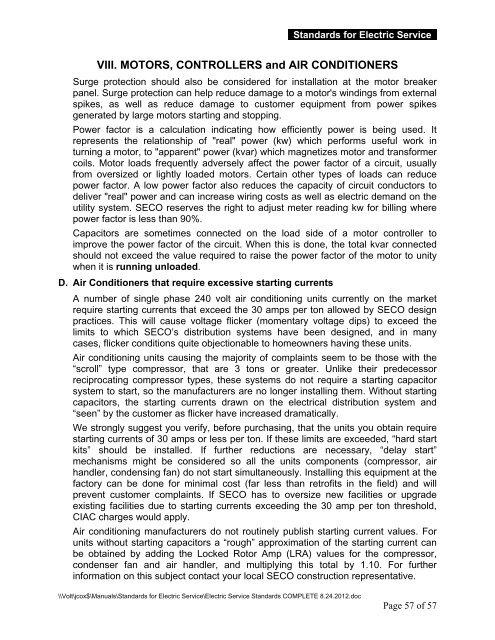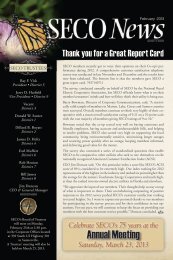Electric Service Standards - SECO Energy
Electric Service Standards - SECO Energy
Electric Service Standards - SECO Energy
You also want an ePaper? Increase the reach of your titles
YUMPU automatically turns print PDFs into web optimized ePapers that Google loves.
<strong>Standards</strong> for <strong>Electric</strong> <strong>Service</strong>x<br />
VIII. MOTORS, CONTROLLERS and AIR CONDITIONERS<br />
Surge protection should also be considered for installation at the motor breaker<br />
panel. Surge protection can help reduce damage to a motor's windings from external<br />
spikes, as well as reduce damage to customer equipment from power spikes<br />
generated by large motors starting and stopping.<br />
Power factor is a calculation indicating how efficiently power is being used. It<br />
represents the relationship of "real" power (kw) which performs useful work in<br />
turning a motor, to "apparent" power (kvar) which magnetizes motor and transformer<br />
coils. Motor loads frequently adversely affect the power factor of a circuit, usually<br />
from oversized or lightly loaded motors. Certain other types of loads can reduce<br />
power factor. A low power factor also reduces the capacity of circuit conductors to<br />
deliver "real" power and can increase wiring costs as well as electric demand on the<br />
utility system. <strong>SECO</strong> reserves the right to adjust meter reading kw for billing where<br />
power factor is less than 90%.<br />
Capacitors are sometimes connected on the load side of a motor controller to<br />
improve the power factor of the circuit. When this is done, the total kvar connected<br />
should not exceed the value required to raise the power factor of the motor to unity<br />
when it is running unloaded.<br />
D. Air Conditioners that require excessive starting currents<br />
A number of single phase 240 volt air conditioning units currently on the market<br />
require starting currents that exceed the 30 amps per ton allowed by <strong>SECO</strong> design<br />
practices. This will cause voltage flicker (momentary voltage dips) to exceed the<br />
limits to which <strong>SECO</strong>’s distribution systems have been designed, and in many<br />
cases, flicker conditions quite objectionable to homeowners having these units.<br />
Air conditioning units causing the majority of complaints seem to be those with the<br />
“scroll” type compressor, that are 3 tons or greater. Unlike their predecessor<br />
reciprocating compressor types, these systems do not require a starting capacitor<br />
system to start, so the manufacturers are no longer installing them. Without starting<br />
capacitors, the starting currents drawn on the electrical distribution system and<br />
“seen” by the customer as flicker have increased dramatically.<br />
We strongly suggest you verify, before purchasing, that the units you obtain require<br />
starting currents of 30 amps or less per ton. If these limits are exceeded, “hard start<br />
kits” should be installed. If further reductions are necessary, “delay start”<br />
mechanisms might be considered so all the units components (compressor, air<br />
handler, condensing fan) do not start simultaneously. Installing this equipment at the<br />
factory can be done for minimal cost (far less than retrofits in the field) and will<br />
prevent customer complaints. If <strong>SECO</strong> has to oversize new facilities or upgrade<br />
existing facilities due to starting currents exceeding the 30 amp per ton threshold,<br />
CIAC charges would apply.<br />
Air conditioning manufacturers do not routinely publish starting current values. For<br />
units without starting capacitors a “rough” approximation of the starting current can<br />
be obtained by adding the Locked Rotor Amp (LRA) values for the compressor,<br />
condenser fan and air handler, and multiplying this total by 1.10. For further<br />
information on this subject contact your local <strong>SECO</strong> construction representative.<br />
\\Volt\jcox$\Manuals\<strong>Standards</strong> for <strong>Electric</strong> <strong>Service</strong>\<strong>Electric</strong> <strong>Service</strong> <strong>Standards</strong> COMPLETE 8.24.2012.doc<br />
Page 57 of 57








